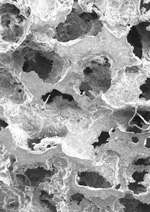Magnetic Alloy With Swiss Cheese Structure Morphs Shape

Researchers have turned a stubborn alloy into a shape-shifting foam by just giving it a little breathing room.
David Dunand, James N. and Margie M. Krebs Professor of Materials Science and Engineering in Northwestern University's McCormick School of Engineering and Applied Science, has teamed up with Boise State University professor Peter Müllner and McCormick postdoctoral fellow Vee Boonyongmaneerat to create a foam from a nickel-manganese-gallium alloy (Ni-Mn-Ga) that changes shape when exposed to a magnetic field. The new foam could translate to smaller, lighter pumps and more aerodynamic airplane wings.
When exposed to a magnetic field, a single crystal of the Ni-Mn-Ga alloy will deform approximately 10 percent. The alloy then retains its new shape when the field is turned off but returns to its original shape if the field is rotated 90 degrees. That's what scientists call “magnetic shape-memory.”
But most materials are “polycrystals,” consisting of a collection of randomly oriented crystals, making a patchwork similar to marble. In polycrystals each individual grain moves in a different direction when exposed to the magnetic field, and the overall deformation is cancelled such that the alloy ends up not moving at all.
Single crystals are extremely expensive and time-consuming to make — just like single-crystalline gems — so when Dunand and Müllner met at a conference in 2006, they decided to combine Müllner's knowledge of magnetic shape-memory materials with Dunand's knowledge of metallic foam. They hoped a polycrystalline foam of the alloy, which looks like a sponge, would allow more space for individual crystals to move, retaining properties similar to a single crystal.
Boonyongmaneerat was working on a project using nickel foams to make fuel cells so the researchers decided to use his process to create the Ni-Mn-Ga foam. The researchers took powders of oxide and pushed the liquid metal alloy between the powders, creating a composite. They then removed the oxide powders from the composite with acid — leaving behind a metallic foam.
That just left the burning question: Would the foam change shape?
To find out, Dunand shipped the foam to Boise State where Müllner and his student Marcus Chmielus tested the foam in a magnetic field rotation. Though it didn't move the 10 percent that a single crystal would, it did move 0.12 percent.
”It was very exciting because we went from zero to an actual value, albeit small, but comparable to the best competitor,” Dunand said.
That competitor is Terfenol D, another material that also moves magnetically under a different mechanism. That material, which has been around for a long time and is expensive to make, is already maxed out at 0.12 percent deformation.
Dunand thinks that once the Ni-Mn-Ga foam is optimized — through casting it differently or perhaps heat-treating it differently — it will provide better results. He believes that such a foam could be a lighter, cheaper replacement for Terfenol D applications like sonar, actuators and magnetomechanical sensors. Dunand also believes the foam could replace applications that require small, rapid movement, like very small motors that don't have room for normal motor components like rotors, stators, gears and shafts, possibly for biomedical applications.
The material could have even bigger applications. Dunand said it's possible that the foam could eventually be used to control slight changes in the shape of airplane wings to make them more aerodynamic based on the speed of the aircraft.
“The dream or the goal is to be able to change, ever so slightly, the aerodynamics of the flow of air to make the flight more efficient at all speeds,” he said.
Dunand and Müllner co-authored a paper on the research that was published last month by the journal Physical Review Letters. The researchers will continue to optimize the strains of the foams by examining both processing and foam architecture. Northwestern and Boise State have jointly filed an application for a patent.
Source: Northwestern University





















